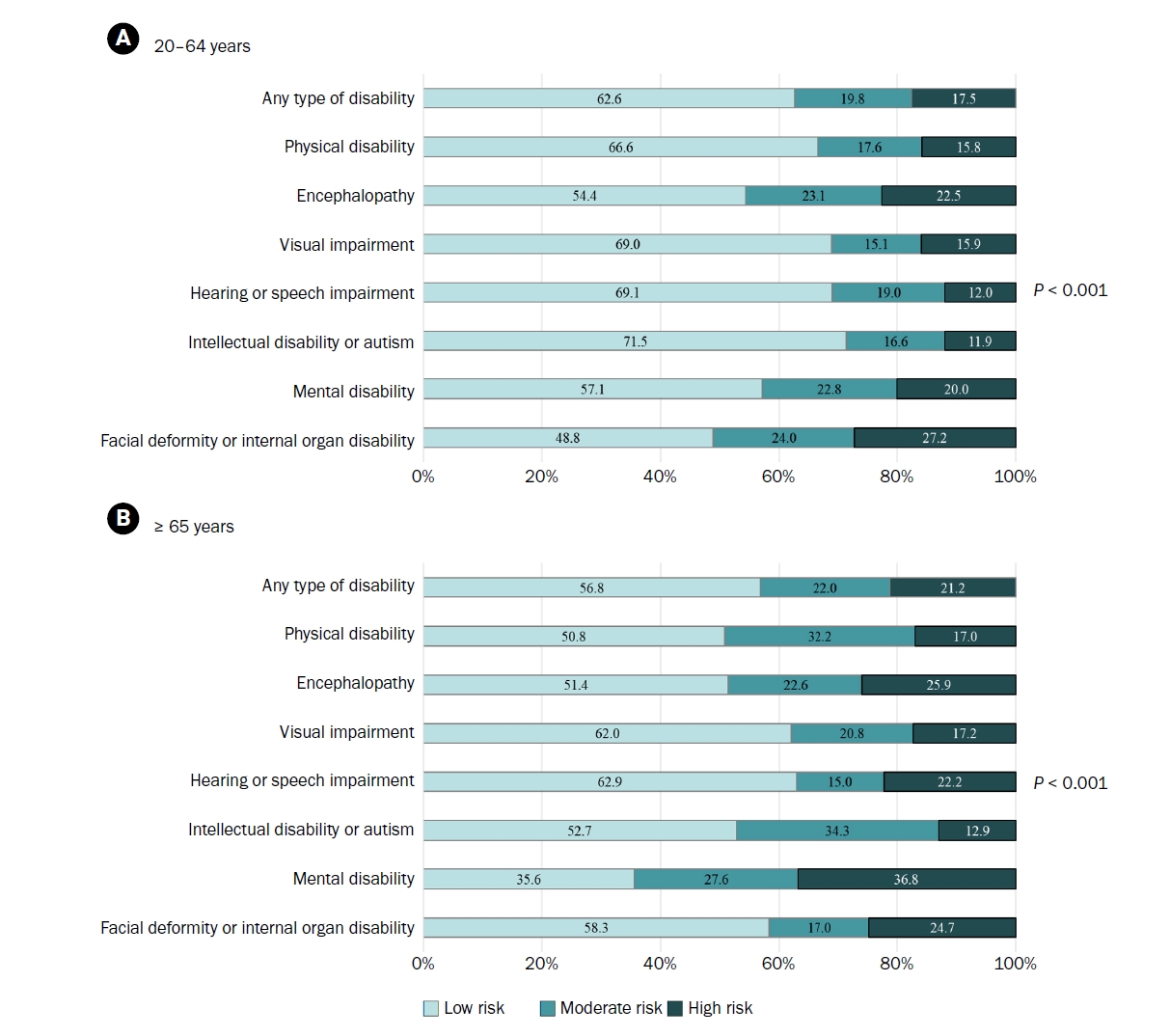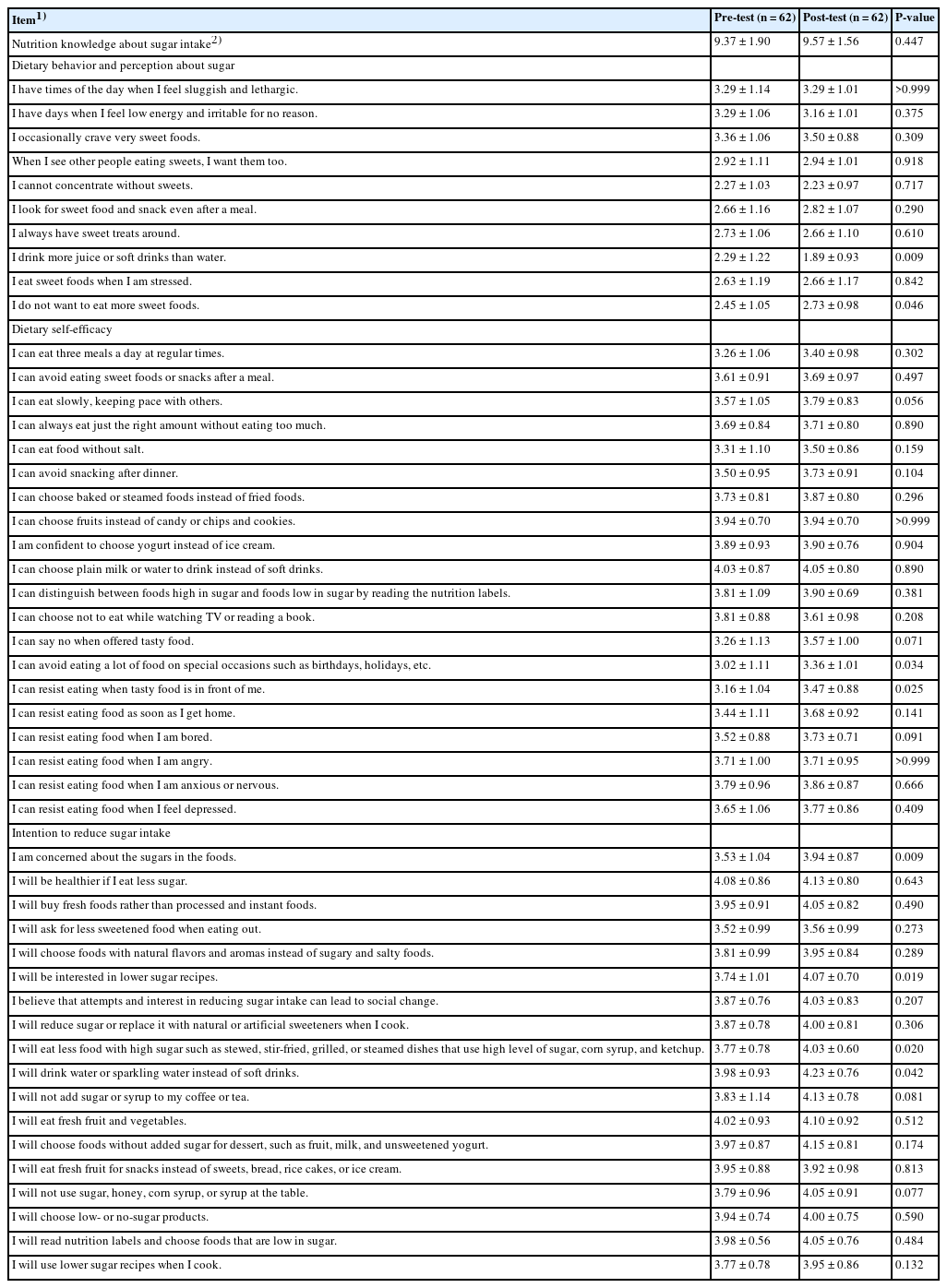Search
- Page Path
- HOME > Search
Research Articles
- [Korean]
- Factors associated with nutritional risk among disabled persons in the Republic of Korea: a cross-sectional study using 2020 Disability and Life Dynamics Panel
- Seong-Ah Kim, Seul Ki Choi
- Korean J Community Nutr 2025;30(5):364-375. Published online October 31, 2025
- DOI: https://doi.org/10.5720/kjcn.2025.00262

-
 Abstract
Abstract
 PDF
PDF - Objectives
Persons with disabilities face heightened nutritional risks due to barriers in dietary management, yet research remains limited. This study examined the nutritional health status and associated risk factors among disabled adults in Korea.
Methods
Data were drawn from the 2020 Disability and Life Dynamics Panel, a nationally representative survey of registered disabled Koreans aged ≥ 20 years. Nutritional health was assessed using the Nutrition Screening Initiative checklist and categorized as low, moderate, or high risk. Multivariate multinomial logistic regression was applied to identify predictors of nutritional risk.
Results
Among adults with disabilities aged 20–64 years, the prevalence of low, moderate, and high nutritional risk was 62.6%, 19.8%, and 17.5%, respectively. In the ≥ 65 years group, the distribution was 56.8% (low), 22.0% (moderate), and 21.2% (high). Moderate to high nutritional risk was most prevalent among individuals with facial deformity or internal organ disability (51.2%) in the 20–64 years group, and those with mental disabilities (61.7%) in the ≥ 65 years group. Significant predictors of high nutritional risk included living alone, lowest income quartile, chronic disease, depressive symptoms, and perceived underweight for both age groups. Compared with visual or speech impairments, facial deformity or internal organ disability (in the 20–64 years group) and physical disability (in the ≥ 65 years group) were significantly associated with moderate or high nutritional risk.
Conclusion
Nearly 40% of disabled Koreans are at nutritional risk. Tailored dietary interventions that address disability type, socioeconomic status, and health conditions are required to reduce disparities in nutritional health.
- 346 View
- 16 Download

- [Korean]
- Development and application of a dietary program to reduce sugar intake using a living lab approach in Korea: an intervention study
- Jung-Hyun Kim, Min Sook Kyung, Seul Ki Choi
- Korean J Community Nutr 2024;29(6):504-513. Published online December 31, 2024
- DOI: https://doi.org/10.5720/kjcn.2024.00318

-
 Abstract
Abstract
 PDF
PDF - Objectives
This study aimed to develop and apply a dietary program to reduce sugar intake among community residents using a Living Lab approach.
Methods
We developed and applied a community-based dietary program to reduce sugar intake. Participants were recruited from community organizations, including a children’s food service management center, elementary to high schools, a university, a family center, a community health center, and an elderly welfare center. The dietary program was conducted in two phases; start and next levels. The start level included a pre-assessment of dietary behaviors and participation in educational platforms, whereas the next level included activities using educational platforms, tailored mission and feedback, and pre- and post-surveys. Extension educators at each community organization implemented the dietary program following organization-specific guidelines. Changes in participants’ nutrition knowledge, dietary behaviors and perceptions, self-efficacy, intention to reduce sugar intake, and participants’ program satisfaction were analyzed using paired t-tests.
Results
In total, 1,238 and 339 individuals participated in the start and next level, respectively. Participants reported significantly lower scores on dietary behavior items regarding drinking more juice or soft drinks after program participation (P = 0.009) and craving sweet foods (P = 0.046). They reported a higher intention to take interest in sugar content in food (P = 0.009) and lower-sugar recipes (P = 0.019), eat less food with high sugar content (P = 0.020), and drink water or sparkling water instead of soft drinks (P = 0.042). Nutrition knowledge did not significantly change after program participation. Program satisfaction significantly increased from the start level to the next level (P<0.050).
Conclusion
This study showed the potential of using a Living Lab approach to implement community-wide dietary interventions. Further research is required to evaluate the effectiveness of the Living Lab approach in various community settings.
- 1,661 View
- 55 Download

Original Articles
- [English]
- Monitoring of Genetically Modified Bean Sprouts at Traditional Markets in Seoul and a Survey of Perception of Traditional Market Merchants and High School Students on Genetically Modified Organisms
- Seul Ki Choi, Jung Hoon Lim, Jee Seong Shin, Jin An Jeong, Hyojee Joung
- Korean J Community Nutr 2010;15(5):679-686. Published online October 31, 2010
-
 Abstract
Abstract
 PDF
PDF - The purpose of this study is to monitor genetically modified bean sprouts at traditional markets in Seoul and to investigate perception of traditional market merchants and high school students on genetically modified organisms (GMOs). We analyzed 30 bean sprouts that were selected at 11 traditional markets in Seoul using the method of polymerase chain reaction (PCR). Also, we compared perception of GMOs between merchants (n = 30) and students (n = 126). Knowledge test about GMOs was performed by students. The result of PCR, 16.7% of bean sprouts were confirmed as GM bean sprouts (n = 5). Students had significantly more exposure to information about GMOs than merchants (p < 0.05). Major information sources about GMOs were from mass media (television, newspaper and radio). About half of subjects were not aware that they eat GMOs and GMOs are sold to consumers. Only 17.3% of subjects had constant eating intent for GMOs after perceiving foods that he/she usually eats are GMOs. 51.3% of subjects had willingness to purchase GMOs if GMOs have same quality and lower cost than natural foods. 37.2% of subjects thought that GMOs would be harmful to humans. Students had more positive perception of GMOs' side effects than merchants (p < 0.01). There was no merchant who knew labeling of GMOs. 19.1% of students knew labeling of GMOs. Students' mean percentage of correct answers of six questions about GMOs was 45.2%. Therefore, providing adequate information about GMOs is needed for consumer's choice whether to purchase GMOs or not.
- 242 View
- 0 Download

- [English]
- Snacking Behaviors of Middle and High School Students in Seoul
- Seul Ki Choi, Hyeon Jeong Choi, Nam Soo Chang, Sung Hee Cho, Young Sun Choi, Hye Kyung Park, Hyo Jee Joung
- Korean J Community Nutr 2008;13(2):199-206. Published online April 30, 2008
-
 Abstract
Abstract
 PDF
PDF - The purpose of this study was to investigate snacking behavior in adolescents. We selected one middle school and one high school in 11 school districts in Seoul. The subjects were 1,813 students (904 boys and 909 girls) in 21 schools (11 middle schools and 10 high schools). Subjects reported their snacking behavior: snack frequency, snack type, snack time, with whom to eat snack, place to purchase snack. The subjects were classified into four groups by gender and schooling. The mean snack frequency was 2.8. Girls ate snacks more frequently than boys (p < 0.001). More than half of subjects ate 1 to 3 snacks a day. Only 9.3% of them did not eat any snack. Tangerine was highly ranked in snack type. Each subject groups had different snack time (p < 0.01) and type of snack (p < 0.001). Most snack was consumed alone (46.6%), however they mainly ate fruits and other foods with family. 46.9% of snacks were purchased outside. A typical snack time was 'before dinner' for most snacks except fruits. Unhealthy foods like soft drinks, cookies, chips, candies, chocolates, ice creams had relatively high proportion in snack consumption with friends. In conclusion, adolescents had different snacking behaviors by their age and gender. These results indicate necessities of multi-dimensional efforts at home, school, media and government level considering adolescents' age and gender for their healthy snacking behavior.
- 365 View
- 6 Download


 KSCN
KSCN
 First
First Prev
Prev



